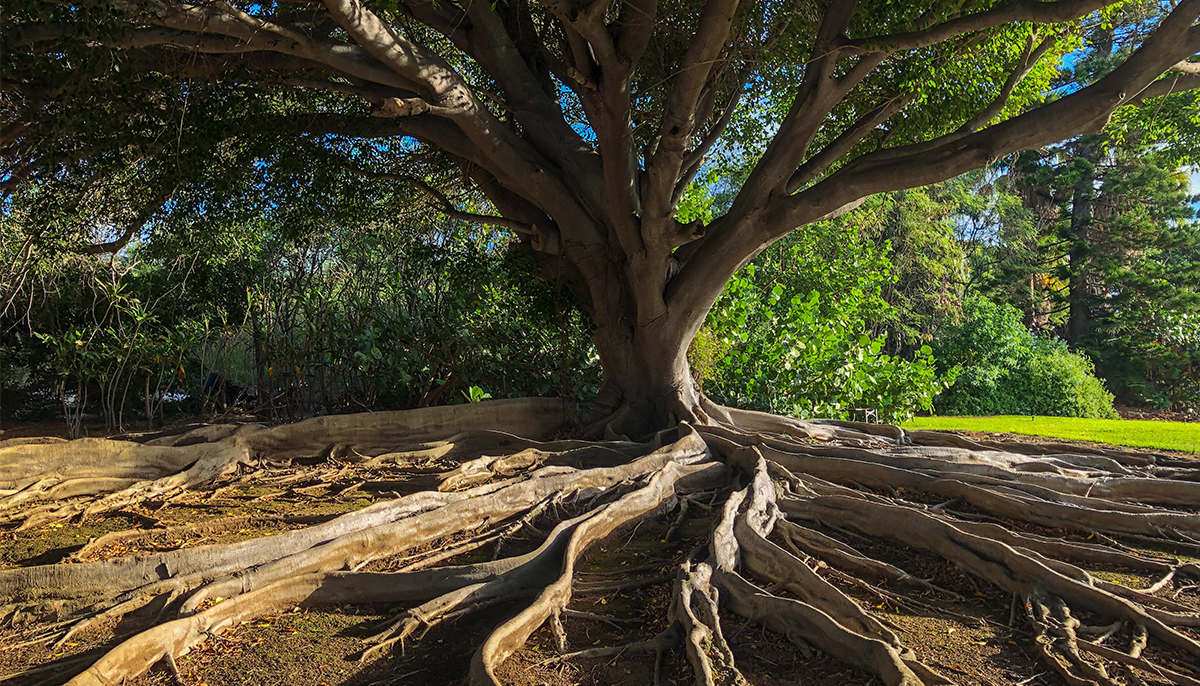Becoming the Ally of All Beings
A teaching by Sharon Salzberg on the interconnectedness of all things. The post Becoming the Ally of All Beings appeared first on Lion’s Roar.

In the Buddhist tradition, bodhisattvas are those who, aspiring to enlightenment, make a resolve, “I vow to attain full enlightenment for the sake of all sentient beings.” That is a pretty incredible vow! It means that we recognize our own liberation is intertwined with the liberation of all beings without exception. It means that, rather than seeing other beings as adversaries, we must see them as colleagues in this endeavor of freedom. Rather than viewing others with fear or contempt, which arises from a belief in separation, we see them as part of who we ourselves are. Seeing the truth of this fundamental interconnectedness is what is known in the Eightfold Path as right view.
The Buddha said, “Just as the dawn is the forerunner and the first indication of the rising sun, so is right view the forerunner and the first indication of wholesome states.” As dawn leads to sunrise, seeing the truth of our interconnectedness leads to the mind-state of loving-kindness that characterizes the bodhisattva. With loving-kindness we become the ally of all beings everywhere. We might think, “That’s impossible. How can I be the ally of those who have hurt me personally, or of those who seem to intentionally hurt others? How can I care about countless beings?”
True, the bodhisattva aspiration does seem to be up against some insurmountable odds. A friend expressed this once to me when we were standing in Red Square in Moscow, which was teeming with people. There were exotic-looking gypsies and people who appeared to be stepping out of another century walking right alongside contemporary business people. Overwhelmed by the sheer numbers and the incredible variety of people, my friend turned to me and said, “I think I’m giving up my bodhisattva vow.”
Loving-kindness is a capacity we all have. We only have to see things as they actually are.
It may seem impossible to genuinely care about all beings everywhere. But developing the heart of loving-kindness is not about straining, not about gritting your teeth and, though seething with anger, somehow covering it over with a positive sentiment. Loving-kindness is a capacity we all have. We only have to see things as they actually are.
When we take the time to be quiet, to be still, we begin to see the web of conditions, which is the force of life itself, as it comes together to produce each moment. When we look deeply, we see constant change; we look into the face of impermanence, insubstantiality, lack of solidity. As the Buddha pointed out, given this truth, trying to control that which can never be controlled will not give us security or safety, will not give us final happiness. In fact, trying to control ever-changing and insubstantial phenomena is what gives rise to our sense of isolation and fragmentation. When we try to hold on to something that is crumbling or falling apart, and we see that not only is it crumbling but we are changing in just the same way, then there’s fear, terror, separation and a lot of suffering.
If we re-vision our world and our relationship to it so that we are no longer trying to fruitlessly control but rather are connecting deeply to things as they are, then we see through the insubstantiality of all things to our fundamental interconnectedness. Being fully connected to our own experience, excluding no aspect of it, guides us right through to our connectedness with all beings. There are no barriers; there is no separation. We are not standing apart from anything or anyone. We are never alone in our suffering, and we are not alone in our joy, because all of life is a swirl of conditions, a swirl of mutual influences coming together and coming apart. By going to the heart of any one thing, we see all things. We see the very nature of life.
Upon closer examination, we come to understand that each aspect of our present reality arises from a vast ocean of conditions that come together and come apart at every moment.
There was a monk in the Buddha’s time, it is said, who originally came from an extremely wealthy aristocratic family. Because he had lived a very pampered life, he was ignorant about some of the simplest things, which made him the object of much teasing by the other monks. One day they asked him, “Where does rice come from, brother?” He replied, “It comes from a golden bowl.” And when they asked him, “Where does milk come from, brother?” he answered, “It comes from a silver bowl.”
In some ways, our own perceptions about the nature of existence may be a bit like those of that monk. When we attempt to understand how our lives work, if we do not look closely, we may see only superficial connections and relationships forming our world. Upon closer examination, we come to understand that each aspect of our present reality arises not from “golden and silver bowls” but rather from a vast ocean of conditions that come together and come apart at every moment. Seeing this is the root of compassion and loving-kindness. All things, when seen clearly, are not independent but rather are interdependent with all other things, with the universe, with life itself.
At the celebration of the twentieth anniversary of the Insight Meditation Society, some young adults planted a tree in the garden. When we look at that tree, we can see it as a distinct and separate object, standing alone, a singular thing. But on another level of perception, its existence is the consequence and the manifestation of a subtle net of relationships. The idea to plant the tree had arisen in someone’s mind as a thought one day, and the idea for some young people to plant it had arisen in my mind another day. The earth that received the tree had been nurtured by a succession of people who had lived at or visited IMS. The twentieth anniversary came to pass because of the enthusiasm and support of so many people over so many years. Each of the young adults who planted the tree had come to have a connection with meditation through varying life experiences.
The tree is now affected by the rain that falls upon it, by the wind that moves through and around it. It is affected by the weather and by the quality of air. We know that pollution creates acid rain, which impacts our tree. We hear that a variable as subtle as a butterfly flapping its wings in China affects the weather pattern in Massachusetts, and so events on the other side of the planet are affecting our tree. Every individual who now sees or touches the tree has arrived at IMS as the result of many forces in the universe converging to make his or her visit possible.
In the same way, we are all part of each other’s life and journey toward liberation. One of my favorite things to do when I am sitting in front of a hall full of meditation students is to sense how many beings brought us all together there in one way or another. How many friends, loved ones, people we’ve had difficulty with, have in some way influenced our life to be there? I think of the lineage of teachers extending from the time of the Buddha, the men, women, and even children who had the courage in life to take a risk, the willingness to be different, to look at the nature of their lives and of their minds in a way that was not conventional. I feel how many people, past and present, are in some way a part of why I am sitting in that hall at that moment, and I sense their presence there too.
I couldn’t even begin to trace the number of influences, encounters, conversations, meetings, partings, times of sharing great joy and times of pain or loss that have brought me to that particular time and place. It’s not exactly like a slide show in my mind; it’s almost more like a kaleidoscope—with just one turn, all of the glass moves and shifts into a new and different configuration and a different pattern.
This is a vast web of interconnectedness that doesn’t seem to have a beginning, doesn’t seem to have any solidity, doesn’t seem to have any boundary.
Loving-kindness is not an object, it is an essential way of seeing that arises when we free ourselves from our normal mental habits that create division and boundaries and barriers, that create a sense of self and other.
Seeing this vision of vastness, of interconnectedness, gives rise to loving-kindness. We look at a tree and see it not as a seemingly solitary, singular entity but as a set of relationships—of elements and forces and contingencies all connecting in constant motion: the seed that was planted, and the quality of the soil that received the seed; the quality of the air, and the sunlight, the moonlight, the wind. That is the tree. In the same way, each of us in every moment is a set of relationships. That is lovingkindness. It is a view rather than a feeling. It is a view that arises from a radical perception of nonseparateness.
In teaching loving-kindness, I have found that people are afraid when they think of it as a sentiment—afraid that they’re not capable of feeling it, afraid that they will feel hypocritical or complacent if they try. But loving-kindness is not a manufactured emotion. As soon as we define it as a certain feeling, we make it into an object, a thing, something we give or don’t give, something we have or don’t have, something we might have to produce on demand, like a card on Valentine’s Day. Loving-kindness is not an object, it is an essential way of seeing that arises when we free ourselves from our normal mental habits that create division and boundaries and barriers, that create a sense of self and other. The practice of loving-kindness is a relinquishing, a coming back, a relaxing into our natural state of mind.
Almost from my first acquaintance with dharma practice, I heard that loving-kindness and compassion were elements or manifestations of the natural state of mind. I would hear that and think, “No way. Look at this world—it’s a mess. I’m also a mess. There’s just no way that these qualities can be the natural state of the mind.” But as I have continued to investigate life, what I’ve come to see again and again and again, without a single exception ever, is that when I see things more clearly, when I can be a little more still and not rush to judgment, when I learn something about somebody or about myself, even if it is just information, when I see a situation or a person more clearly, I am always brought to a greater sense of connection, to a greater sense of loving-kindness. Never has clearer seeing led to more separation or distance, more alienation or fear. Not once.
A friend of mine was a wonderfully empathic therapist. One day a man came to see her, beseeching her to take him as a client. She found his political views alienating, his feelings about women repugnant and his behavior quite annoying. In short, she didn’t like him at all and urged him to find another therapist. However, because he very much wanted to work with her, she finally acquiesced.
Now, because he was her client, she tried to look at his unskillful behavior, and the ways he shut himself off, with compassion instead of contempt and fear. As they worked together, she began to see all the ways in which his life was very difficult. She began to see that he longed—as she herself did—for happiness and how, like her, he suffered. Although she continued to recognize, without denial, his unpleasant behavior, she found that she did so with the feeling that she was necessarily his ally. The goal became his release from suffering. He had become “hers.” Even though I don’t believe she ever liked him, or approved of many of his views, she came to love him.
Love and compassion are not conceptual states, they’re not things we put on as a kind of veneer or pretense, not something we are obliged to parrot, no matter what we are actually feeling. When we let go of our concepts of duality and separation, then love, which is connection, and compassion, which is kindness, arise as reflections of the mind’s natural state. This is not just a nice idea; this is something very real and fundamental.
The Buddha once said, “Develop a mind so filled with love that it resembles space, which cannot be pointed, cannot be marred, cannot be ruined.” Imagine throwing paint around in vast, endless space. There is nowhere for the paint to land. It doesn’t matter whether it was a beautiful choice of color or not. It doesn’t matter, because there is nowhere that the space is going to be painted or marred or ruined by it. When we relax the divisions that we usually make, the mind becomes like space. This is not something that a fortunate few have the capacity to experience; it is the nature of the mind, which every one of us has the ability to know.
We are all bodhisattvas, not in the sense of being saviors running around taking care of everybody’s problems, but through the truth of interconnectedness.
In talking about practice, Tsoknyi Rinpoche, a Tibetan teacher, said we practice in order to learn to trust ourselves more, to get confidence in what we know, to have faith rather than doubt. Loving-kindness and compassion are innate capacities that we all have. This capacity to care, to be at one with, to connect, is something that isn’t destroyed, no matter what we may go through. No matter what our life experience may have been, no matter how many scars we bear, that ability remains intact. And so we practice meditation in order to return to that spaciousness and to learn to trust our ability to love.
We are all bodhisattvas, not in the sense of being saviors running around taking care of everybody’s problems, but through the truth of interconnectedness. There is no separation. We all belong to each other. This, of course, can be a very difficult place to act from in the course of our daily lives. A friend of mine was once home alone when the doorbell rang. When he opened the door, he found himself facing a disheveled, wild-looking person. As my friend attempted to get this stranger to leave, the man looked at him and said sadly, “Don’t you know me anymore?” They had, in fact, never before met. While it was probably wise to refuse the man entry, his words were a tremendous teaching: “Don’t you know me anymore? Don’t you recognize me as a part of your life?” To be a bodhisattva, to open to our capacity for loving-kindness, is more a matter of recognition of our interconnectedness than a dictum for certain kinds of actions.
We are essentially no different from each other, no matter who we are. We share the same urge toward happiness, and not one of us leaves this earth without having suffered. As the Buddha said, “All beings everywhere want to be happy.” It is only due to ignorance that we do the things that create suffering or sorrow for ourselves and for others. If we take the time to slow down and see all the different forces coming together in any action, we will see this desire for happiness even in the midst of some terribly harmful action. While we can and should take a strong stand against harmful behavior, we can do so without disconnecting ourselves from anyone. This is compassion and loving-kindness based on clear seeing.
Just as the root of the Buddha’s psychological teaching is that we will never find happiness in trying to control what cannot be controlled, the root of his moral teaching is empathy—understanding that all beings want to be happy and that suffering hurts others in the same way that it hurts us. We use our mindfulness practice to notice our feelings and to understand them. Through that we can see very clearly that if we are immersed in tremendous anger, it is great suffering. It is a state of burning, of contradiction and isolation, of separation and fear. We see this relative nature of anger as well as its more ultimate, impermanent, insubstantial, transparent nature. On the relative level, it is painful; it hurts. We can learn not to consider anger as bad or evil. We don’t have to reject the anger or reflect or condemn ourselves for it, but rather we can feel compassion for the pain of it. And then we understand that when others are engulfed by anger they are suffering, just the way we suffer when we’re lost in that state.
This quality of empathy is also the basis of modern psychological thought on the development of morality. We learn not to hurt others because we understand how it feels to be hurt. If others are seen as objects rather than as sensitive beings, it’s quite easy to harm. But if we understand, from within, the pain that others would experience from our actions, then there arises a clear and true sense of morality.
Empathy and nonseparation are the most fundamental aspects of loving-kindness. This is what we need to recognize as loving-kindness: a radical seeing of our nonseparateness, knowing our oneness, our indivisibility. When we see through ignorance and arrive at the heart of our interconnectedness, it is as if we had been living in a bad dream, and our anguish and sorrow were born of simply not seeing. From clear seeing arises the uncontrived loving-kindness that is the truth of our bodhisattva nature.
Reprinted from Voices of Insight, edited by Sharon Salzberg, with permission of Shambhala Publications.

Sharon Salzberg is co-founder of Insight Meditation Society in Barre, Massachusetts, and the author of many books, including the New York Times bestseller, Real Happiness; her seminal work, Lovingkindness; and her latest, Real Change: Mindfulness To Heal Ourselves and the World.

 Koichiko
Koichiko 































